1/18 scale Bölkow Bo-102 Helitrainer scratchbuild
Nereden Yazdýrýldýðý: ModelSitesi
Kategori: Plastik Modeller
Forum Adý: Tayyareler
Forum Tanýmlamasý: Uçabilen hersey hakkinda bilgi alisverisi alani
URL: www.modelsitesi.com/forum2/forum_posts.asp?TID=7455
Tarih: 13/12/2025 Saat 23:14
Program Versiyonu: Web Wiz Forums 8.04 - http://www.webwizforums.com
Konu: 1/18 scale Bölkow Bo-102 Helitrainer scratchbuild
Mesajý Yazan: Nick_Karatzides
Konu: 1/18 scale Bölkow Bo-102 Helitrainer scratchbuild
Mesaj Tarihi: 23/06/2011 Saat 15:43
|
The Bölkow Bö-102 Helitrainer was an unusual ground-based helicopter training aid that was developed and built by Bölkow of Germany in the late 1950ies. It embodied all essential elements of a conventional helicopter, but was mounted on an articulated gantry to allow a student controlled experience of helicopter systems. Designed to be mounted on a swivelling captive rig the Bölkow Bö-102 Helitrainer allowed trainee pilots to practice procedures such as engine starting, rotor engagement and manipulation of the flight controls. Many of the Bö-102's components, including the single bladed fiberglass main rotor were used in the company's next design, the Bölkow Bö-103. 
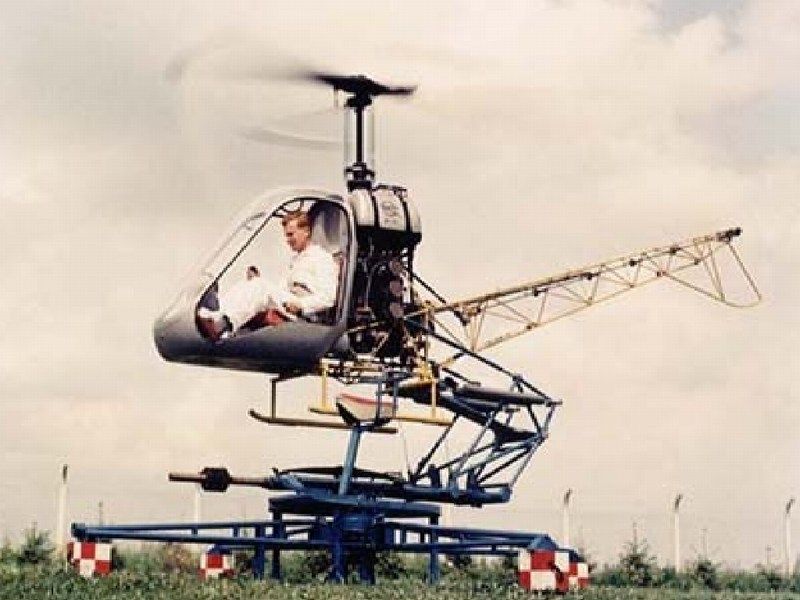
 Looks like a kiddie heliride, a toy for big boys huh?  Rolled out in 1957, this Helitrainer was powered by a Hirth 3-cylinder / 2-stroke 40hp ILO L3X375 piston engine rated at 30 kW, driving a simple 21 foot one-bladed fiberglass rotor with a counterweight. In all 18 of these Helitrainers were built operating throughout Europe, training military helicopter pilots. Although unable to fly, they were ideal for the teaching of hovering techniques and were replaced by dual trainer helicopters. 

 The Bölkow Bö-102 Helitrainer offered a variety of advantages for a safe helicopter training and was developed in land and water based versions, both of which were semi-captive. The first training section was conducted on this model mounted on a boogie. It facilitated the training of starting, tuning the rotary speed, taking off, hovering, turning, and landing. Simple exercising device for beginners’ training. Safety risk minimized by captivation, yet limited flight maneuvers possible. This feature allowed the helicopter to rise to a height of 2m (6ft), turn around a vertical axis and dip at up to 6° but prevented it from flying outside these limits. 
 Unfortunately, the Bölkow Bö-102 Helitrainer did not gain general approval because of its costs being nearly as high as a small helicopter. Luckily, very few of them, are still surviving as public display exhibit at the Hubschraubermuseum Bückeburg Germany, the helicopter museum Weston and in Rota museum Spain. Parts of Bö-102B were found at a freight forwarding company in Vlotho and donated to the helicopter museum in Bückeburg. The workshop team, managed to restore few of these experimental helicopter training devices. 

 Technical data & general characteristics
[*]Usage: Single seated captive helicopter trainer for basic helicopter training [*]Year of construction: 1958 [*]Manufacturer: Bölkow Entwicklungen KG [*]Country: Germany [*]Length: 5.68m [*]Main rotor area: 34.8m² (374feet²) [*]Main rotor diameter: 6.58 m (21ft 8in) [*]Powerplant: 1 x Hirth 3-cylinder / 2-stroke 40hp ILO L3X375 piston engine rated at 30kW [*]Power: 40shp [*]Gross weight: 770kg (1697lb) [*]Take off weight without a platform: 325kg [*]Crew: 1 student pilot & 1 trainer (on additional seat) [*]Speed: Handcuffed on the ground [*]Range: Stationary base coach 
 |
Cevaplar:
Mesajý Yazan: Nick_Karatzides
Mesaj Tarihi: 23/06/2011 Saat 15:46
|
To produce a thin-skinned, right-to-scale cabin, a solid rock one-piece "image cast" of the bubble typed cabin should be made of modeling clay & epoxy first and then try to reproduce a copy by vacuum forming the image cast. Using the following modeling clay item, found in my local supermarket. It's an air-drying modeling clay ideal for scale modeling and shaping. According to the instructions, it can be easily formed into shape, become solid rock withing few hours, re-filled or sanded if necessary and painted or lacquered. That sound quite good to me and similar to the well known Milliput epoxy putty, with the only difference that the 500g air-drying modeling clay pack cost only 1£, instead of 100g Milliput epoxy putty which cost 5£. That makes the new found air-drying modeling clay, about 25 times cheaper than Milliput epoxy putty and that's a good reason for me to give it a chance. 
 I formed the basic shape of the bubble typed cabin, by picking small quantities of this modeling clay with a metal spatula and applying the air-drying modeling clay. It felt too soft and very easy to spread the material nicely. I didn't want to care too much and try forming and shaping the clay, because I was planning to add epoxy putty and sand to make a nice shinny finish. After all, I had no idea how much available time I had, before the material start becoming hard and difficult to handle. 

 The specific polyester filler I used to apply over the clay, comes with the proper catalyst which provides a solid rock build and approximately 3 to 5 minutes time window to form it into shape. I prefer to use epoxy putty or polyester filler with fiberglass grains for special purposes, because:
[*]it does not shrink and does not crack after months or years, [*]you can pour to any shape that you want but you need to work fast because as soon as you mix it with catalyst cream approx 5%, you have limited time before becoming solid rock, [*]you can also put additional layers of epoxy or polyester filler to build up, [*]you can sand it, you can drill it, you can use any type of scale modeling glue, any type of primer or enamel / acrylic paint on it with no problem, [*]can be purchased at any good crafts store into 250ml, 500ml, 1lt (comes with a tube of catalyst hardener) or bigger canisters and if you can't find it, fear not and try your local decent hardware store and finally... [*]it is cheaper than dirt - estimated prices are £3 to £10 depending the canister size, the quality, if contains fiberglass grains for maximum strength etc. Keep in mind that the chemical reaction after mixing the polyester filler with the catalyst hardener, produces some heat that possibly effect on thin plastic parts, so test it first before try it on your scale model. I don’t think that the produced heat is more than Fahrenheit 110, but better watchout. Remember that epoxy materials are dangerous when breath or shallow and could result skin, eyes or lungs problems or even cancer when used for long period with no precaution measures. Always keep in mind, that a powerful vacuum system to suck away the epoxy dust should be used all time to keep the workbench area clean while sanding or milling epoxy or resin materials. Using an issued breathing mask and a pair of surgery latex gloves to prevent dust contact with lungs and fingers while sanding or milling epoxy, is also an important matter that you should seriously take care of! My recommendation is to also wear an overall working suit (as I do) to keep your clothes dust free while sanding epoxy. Some people might find it too much, but I wouldn't like to bring epoxy dust & grains from my work bench into living room and my beloved. As long as this subject relates to our physical health and the physical health of all family members and loved ones who may come into contact with the materials we use in scale modeling, we need to be very careful and suspicious. We all need to be informed on whether it is safe or not about the materials used in scale modeling and what can we do to avoid or minimize the risks of everyday contact. Some of you may wonder if the epoxy putty or dust from the epoxy sanding is actually hazardous to health or if it really causes harm to human body. Some might say that all these are just an urban legend and a pseudo story based on Goebbels theory that has finally become accepted as an illusionary reality. Some might even support the view that these products had passed controls and been inspected by independent and non-controlled health organizations and committees and that if these products were truly dangerous, the companies would not be allowed to produce and would never be free sold in usual drugstore, where ordinary Joe might buy it. Well, should we sleep quietly at night, knowing that anything surrounds us, are truly inspected by independent and non-controlled health organizations and committees? Should we or not? Because as far as I know, the same organizations and committees are those that allow the free sale and use of other products such as cigarettes, asbestos sheets, hazardous petrochemicals etc to millions ordinary Joes daily! Should, I assume that this situation might happens, because nobody has informed them that such products, do kill slowly and painfully? On the other hand, there are thousands of publications in medical conferences and seminars to warn of the dangers that may cause the powdered epoxy resin and the dust produced from the epoxy resin sanding. There are thousands of studies showing a direct relationship of lacquer solvents, toluene thinner, thixotropic agents etc, with serious damage to the human body - including cancer. Is it a well organized theory by Goebbels himself? Surely no! Should we ignore all these warnings? Should we believe that the good companies who only care about consumer’s health and not bothered about the ephemeral economic gain at the expense of our health, check everything thoroughly and would never allow dangerous products in the open market? Some of you may consider an exaggeration to suggest the use of breathing mask, latex gloves and special clothing during the epoxy materials processing, but let me explain my point of view, within only few words.
[*]Having suddenly acquired (me and tens of thousands of fellow citizens in my town, at the exact same time) some strange allergies occurred in the late 90ies, just after the Allied uranium shells bombing in Serbia, which is just few kms away from the city I live, [*]Having lost at the age of 46yo, my mentor in scale modeling and good friend who (coincidentally?) worked continuously in an environment saturated with epoxy resin powder & lacquer thinner fumes, [*]Having lost a second very good friend and highly skilful figure and miniature builder (perhaps the best in Greece at that time) for similar reason... …I think it’s not so good idea to keep pushing my luck and I decided to follow some protection rules. Under no circumstances I propose to live the rest of our lives locked in a sterile glass - this would not be life. I would strongly suggest to live our life as intensely as possible. But keep in mind, that the wise parachutist, always checks thoroughly his main & reserve gear before each jump and does not behave casually leaving his life to luck factor, just because he was lucky so far and didn’t happen to face an emergency. "SAFETY FIRST " became my personal logo and whoever wants, is free to follow. When the cast used as an "image" of the bubble typed cabin, was filled with a layer of polyester filler and had enough time to polymerize and get solid rock, it was sanded carefully to get the right shape. Finally, the cast was sprayed with white shiny finish to help me spot any scratches or defects. 
 |
Mesajý Yazan: Nick_Karatzides
Mesaj Tarihi: 23/06/2011 Saat 15:47
In my previous WIP article about the 1/18 scale Jukka Tervamäki Engineering JT-9T autogyro project, I explain in a very detailed manner, how to build a vacuum forming device, starting from scratch and using materials that can be found in your local super market. If you are not aware how to build a scratchbuilt vacuum form, please feel free to read it as I described and it might be useful for you.


 Heat your electric oven to some predetermined level, whatever works and start heating the plastic sheet. I have never tried this with a gas one, so use caution if you do! Once the plastic gets warm, you’ll notice it will droop down. When you think the plastic is soft enough, fire up the vacuum cleaner, take the plastic from the oven and thrown the sheet on the vacuum former. The plastic will nicely form around the moulds. This will take some practice and sometimes a mould tips over or the plastic won’t form properly over the mould (folding around edges). This is also the part where I should warn you that you can burn your fingers - I highly recommend Nomex Aramid flame resistant MilSpec gloves, which I personally use for the job. I buy large plastic styrene 50x30cm sheets for 0.5€ to 1.5€ each (depending width), not the more expensive styrene by Evergreen. When an attempt fails, I usually throw the sheet back in the oven and start again. Once you have the machine, you can make all kinds of things. You can make a lot of aircraft wings, airframe, panels etc out of a sheet like that. You can make the master molds from basswood, epoxy, polyester etc and the parts you make depend on how accurate the master molds are. The molds must be as accurate and detailed as necessary to achieve the results you are after. As you see in the following pictures, I tried white and clear styrene sheets too, in order to build the cabin by white styrene and the bubble canopy by clear. 

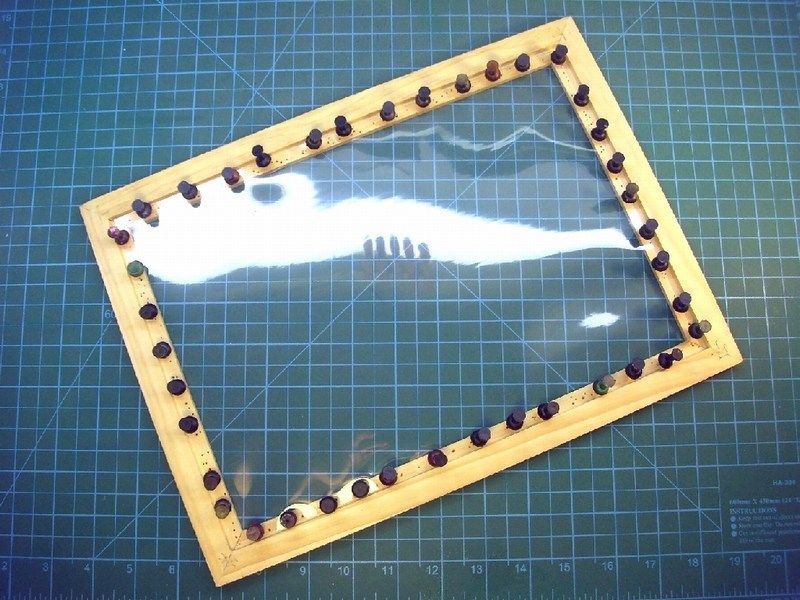
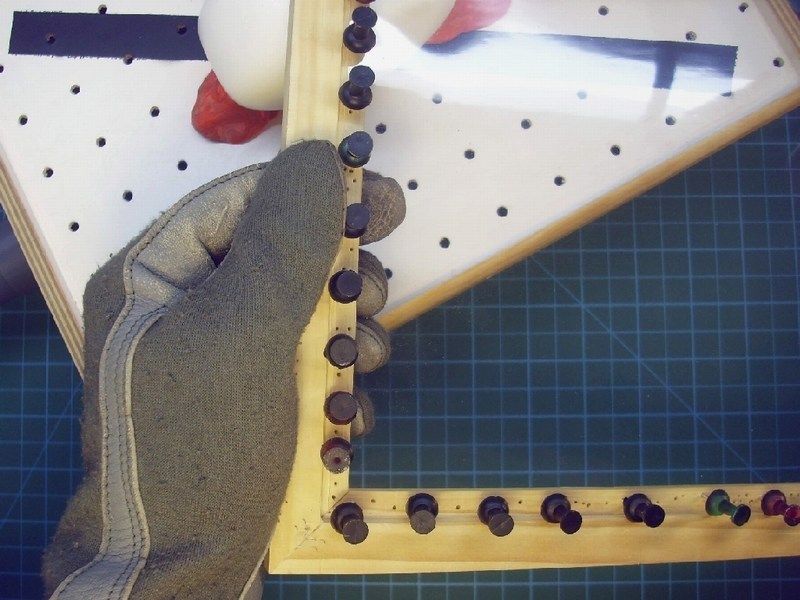

 I placed the frame into the preheated electric oven and I wait few critical seconds watching the plastic start heating. As soon as I noticed that it started drooping down, I removed the frame while wearingNomex Aramid flame resistant MilSpec gloves, to prevent finger burns. While the vacuum cleaner was already switched on, I placed the wooden frame with the pined plastic sheet on the vacuum former plate. The plastic nicely formed around the “virtual” airframe mould... and voila!  Using my X-acto knife, I removed the formed cabin pieces from the styrene white or clear sheets and tried some test fitting on the cast.  |
Mesajý Yazan: Nick_Karatzides
Mesaj Tarihi: 23/06/2011 Saat 15:47
|
As written before, the Bölkow Bö-102 Helitrainer was a helicopter training aid that was developed and built to allow a student pilot controlled experience of helicopter systems. That's why the cockpit panel was so simple, that a 5yo child could operate. Three gauges on the instruments panel, few switches, a cyclic control stick and a collective. That's all! After all, it was not designed to fly, but only give a helicopter hover & flight feeling.  I started by cutting the cockpit’s floor shape in styrene and shape it as required to fit into the cabin.  Once I tried test fitting, I discovered that there was some tiny gaps between the cockpit's floor and the cabin. These gaps, should be filled. So, "mind the gap"!  |
Mesajý Yazan: Nick_Karatzides
Mesaj Tarihi: 23/06/2011 Saat 15:48
To do so, some quantities of liquid modeling putty, filled between the gaping surfaces. In order to make the putty liquid and let it spread naturally and fill the tiny gaps, I mixed Humbrol putty with lacquer thinner. Because the lacquer thinner is volatile, the liquid putty mixture took about 45 minutes to get fully dry and be safe to sand - carefully of course. If you follow this method, be sure that you mix the lacquer thinner and the modeling putty into a metal or glass plate / canister, because the most plastic materials cannot stand it and melt. For this reason, keep in mind to use just the essential lacquer thinner quantity, in order to remain the mixture in liquid form, as it is presented at the following pictures.





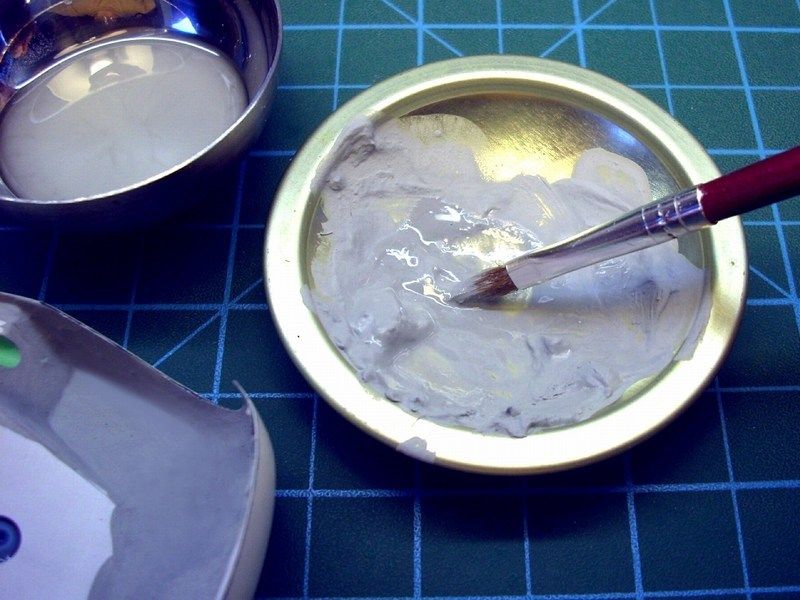
 The last liquid putty layer was applied using the Squadron MMD green putty instead of the general purpose Humbrol, because I personally find it better for final smooth details. 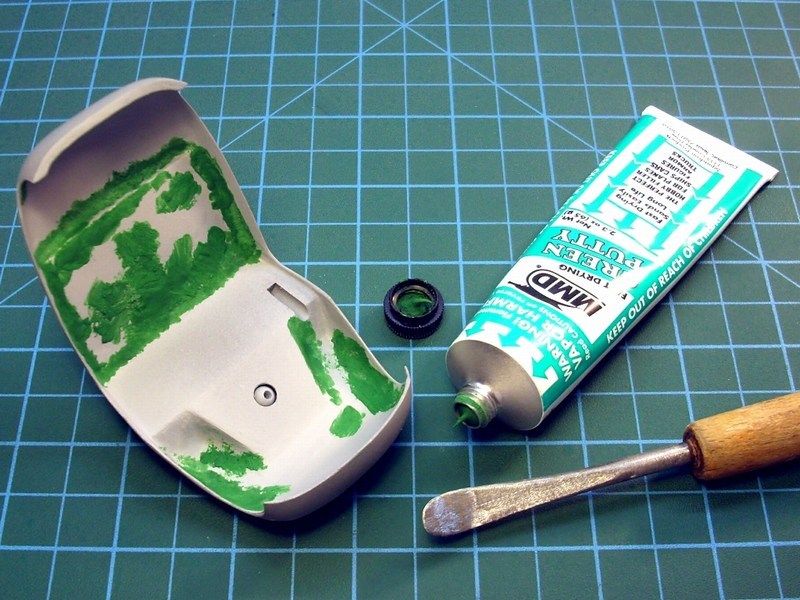 |
Mesajý Yazan: Nick_Karatzides
Mesaj Tarihi: 24/06/2011 Saat 12:32
The Squadron MMD green putty, also used to create some minor details on the cabin’s back side, where the tail boom frame (tail boom construction will be explained later) joints will be later fitted. At last, I tried many test fit attempts with the tail boob, to ensure that I’ll not face any unpleasant surprises later.


 An additional green putty layer applied and the cockpit surfaces carefully sanded to look as smooth as possible, before sprayed with Mr. Surfacer 1200 as a final touch.  The instrument panel is made of standard Milliput epoxy putty, which is popular among modelers and also useful in countless household & restoration applications. Switch board, tail rotor control pedals, cyclic control stick and collective lever are made of drilled & cut styrene plastic card. Wiring is made of 0.20mm diameter fishing line. 




 Using styrene plastic card, I cut the basic lines to form into the student pilot’s seat. The dimensions and the shape are based on actual Bö-102 pictures. Standard Milliput epoxy putty was used to simulate the pillow. Finally, the cabin sprayed with Humbrol light grey acrylic primer to show up any possible scratches that I did not spot so far.. 





 Please keep in mind, that despite the fact that only 18 Bö-102s were produced, the available pictures show that there were many and obvious differences between them in several places. Different seats (some of them were not even seat), different cockpit and cabin colour, different fuel tank canisters, different tail boom frame construction, different landing pad and some of the Bö-102s, were not even equipped with landing skids. So, don’t be surprised if you witness differences. |
Mesajý Yazan: smkaraatli
Mesaj Tarihi: 24/06/2011 Saat 23:08
|
Magnificent work of absolute art and patience!
Thanks for the detailed explanations. Hope to see the finish as soon as possible .. |
Mesajý Yazan: Nick_Karatzides
Mesaj Tarihi: 25/06/2011 Saat 09:48
|
Following the 1/18 scale printed diagrams and using just a sharp #11 blade and superglue, it took about 2 hours to build the basic tail boom frame. The tiny gaps between the connections, were filled with a combination of Squadron MMD white & green putty, applied with an old brush. In order to make the putty liquid and let it spread naturally and fill the tiny gaps, I mixed it with lacquer thinner. As I wrote before, because the lacquer thinner is volatile, the liquid putty mixture took about 45 minutes to get fully dry and be safe to sand - carefully of course. Squadron MMD putty and lacquer thinner mixed into metal (glass is also OK) plate, because the most plastic materials cannot stand it and melt.  Because the Hirth 3-cylinder / 2-stroke 40hp ILO L3X375 piston engine is attached just behind the cabin, placed under the two fuel tank canisters, is clearly visible. Unfortunately, although I tried to avoid it because I am a lazy guy, the engine had to be built from scratch - keep in mind that engine building is my personal scale modelling nightmare. For this reason, I prayed to God to kindly send me a sign or even an ready built engine to fit in my 1/18 scale project. I was expecting for a miracle to happen, but waited in vain. That might means that God has a sense of humor and wanted to see me to spend inconvenience. So, after waiting some more time the miracle to happen and after I finally realized that it was impossible to rain free 1/18 scale engines on my bench, I decided to build one from scratch, using styrene, epoxy putty and a number of absolutely unidentified parts found into my spare box. After completing my attempt, placing the engine into place and airbrushing acrylic primer paint to look unified, I was happily surprised that the result did actually look like a Hirth ILO L3X375 piston engine! 




 |
Mesajý Yazan: Nick_Karatzides
Mesaj Tarihi: 26/06/2011 Saat 20:38
As soon as the joints between the tail boom parts were securely glued with combination of CA super glue and Humbrol liquid polysterine glue and later filled with Squadron MMD green putty on tiny gaps, it was carefully sanded with sand paper and nail files, found at the local supermarket and bought for less than 1 euro per 10 files.


 The following toll attached to my miniplex to reach difficult spots and areas, that sand paper and nail files could not safely operate. 


 |
Mesajý Yazan: Nick_Karatzides
Mesaj Tarihi: 27/06/2011 Saat 10:13
It was about time to sit back and take a break! I asked wife to prepare a nice cold café frappé for me. I had time for a close inspection on the model so far, while she was preparing this refreshment for me. For all you who do no clearly understand what is the café frappé, please let me explain that it is a foam-covered iced coffee drink made from spray-dried instant coffee. It is very popular in Greece especially during summer, but has now spread on to other countries. In French, when describing a drink, the word frappé means shaken and / or chilled; however, in popular Greek culture, the word “frappé” is predominantly taken to refer to the shaking associated with the preparation of a café frappé. For more infos, click http://en.wikipedia.org/wiki/List_of_coffee_beverages#Greek_frapp.C3.A9_coffee - HERE or visit a Greek island during this summer and relax on the beach enjoying a café frappé to feel the Greek way difference.
 You might think that I throw away the plastic straw after drinking the coffee? Hell no! Just wash with water and I had the basic material to build the exhaust tube, right on scale. 

 The tail rotor blade was build by styrene & sprue, airbrushed and dry fitted into place to give me an idea if it looks right. 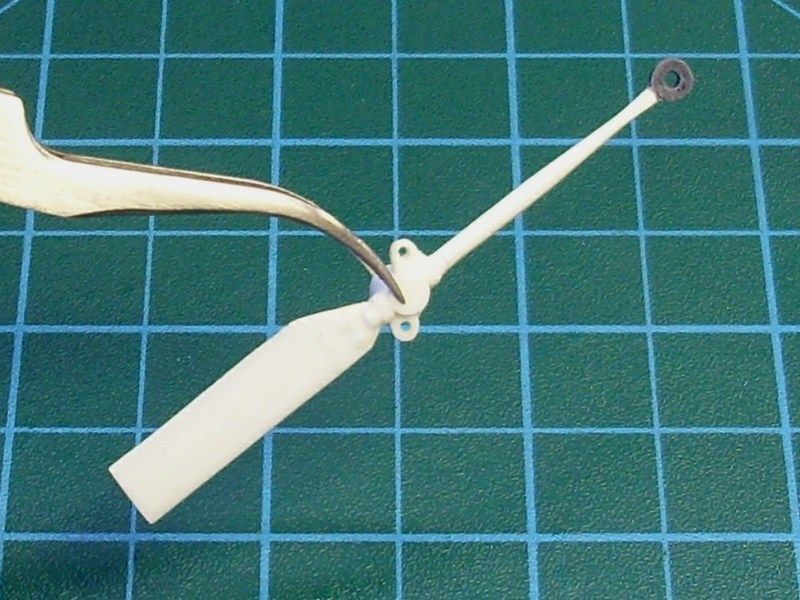
 At last the battery pack was built of epoxy and some cables and flexible air intake hoses added too. Control cables and wiring made of 0.20mm fishing line. Tail boom fins are made of forded copper and styrene. The fuel tank canisters and the fuel lines will later described. Everything covered with a light grey acrylic and placed into box to wait the final painting. 
 |
Mesajý Yazan: Nick_Karatzides
Mesaj Tarihi: 28/06/2011 Saat 10:34
|
Having obtained a number of information data & pictures about the structure and functioning details of the Bölkow Bö-102 Helitrainer, I have concluded, that this training aid could be found in various versions. In most photographs, a solid land-fixed construction is visible, consisting of a system based on 4 sliding legs, stretched around, ensuring secure support. Nevertheless, both diagrams & photographs show that this was not the only version, as there were some Bö-102s which were based on inflatable rubber pads to float on water or wheeled bases which enabled transport of the device in different places, even into a hangar. Careful observation of the individual photographs and archive material showed that there are too many differences between these Bö-102s. Therefore, taking under account that only 18 were produced, I do not think too much to assume that each one of them was completely different from each other. 





 |
Mesajý Yazan: vayhan
Mesaj Tarihi: 28/06/2011 Saat 17:29
| Fantastic build. |
Mesajý Yazan: Nick_Karatzides
Mesaj Tarihi: 29/06/2011 Saat 11:02
For my 1/18 scale project, I chose to recreate the wheeled version, which seemed to me as more interesting than others. As you can see in the following pictures, the landing pad & supporting base was built by styrene plastic, sprue, metal wire and glued with CA super glue and Humbrol liquid polysterine glue.
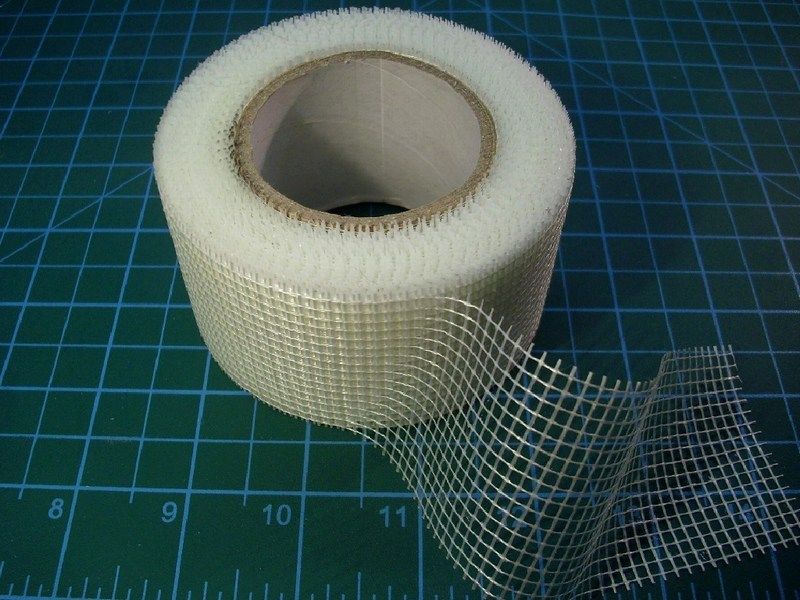

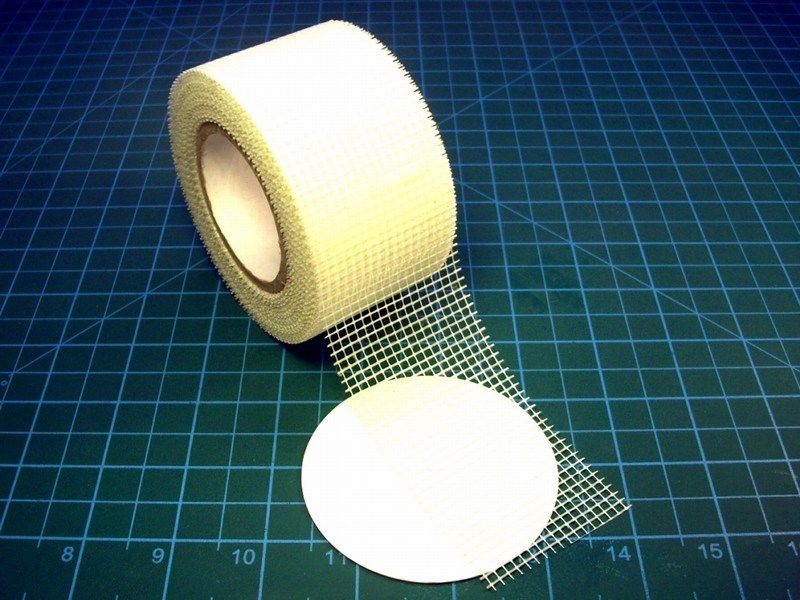
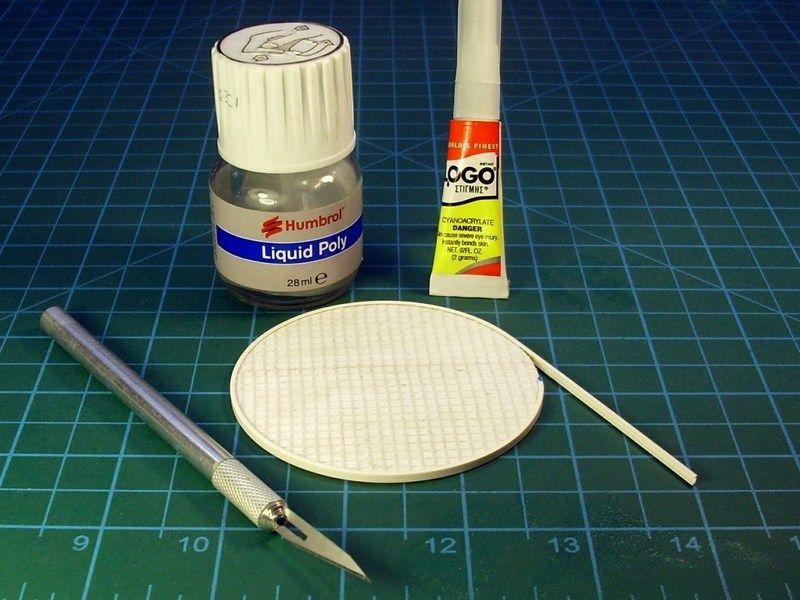

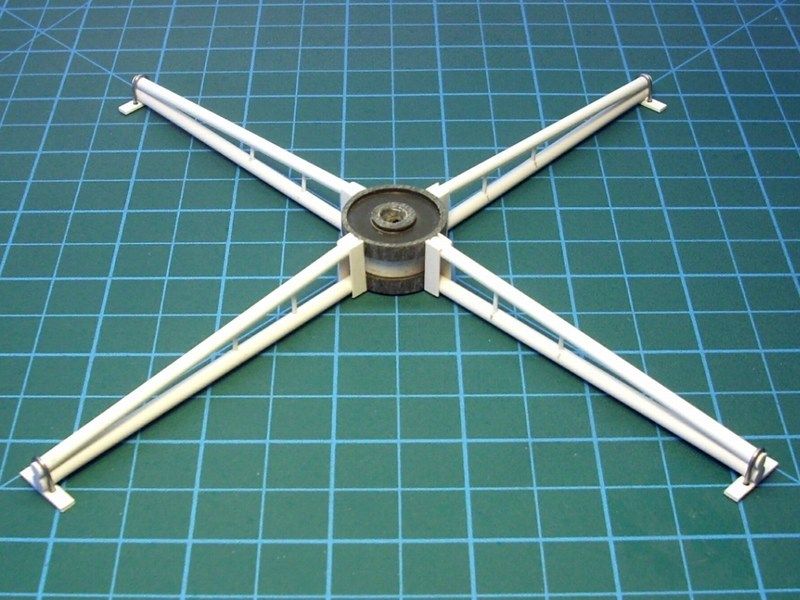

 |
Mesajý Yazan: Nick_Karatzides
Mesaj Tarihi: 30/06/2011 Saat 08:32
When it looked OK to me, it was sprayed over with Humbrol acrylic primer to spot any mistakes and be ready for final paint. Each part was fit tested to ensure that anything can be combined together as one piece.





 |
Mesajý Yazan: Nick_Karatzides
Mesaj Tarihi: 01/07/2011 Saat 14:03
|
Once sprayed with the Humbrol acrylic grey primer the model’s constructed pieces so far, I thought it would be a good idea to use the spray cap in a productive way to construct two identical fuel tank canisters. The reason I chose to use this, is that the cup is made of a quite flexible polyamide material and the Miliput standard epoxy putty could hardly stack onto it. 
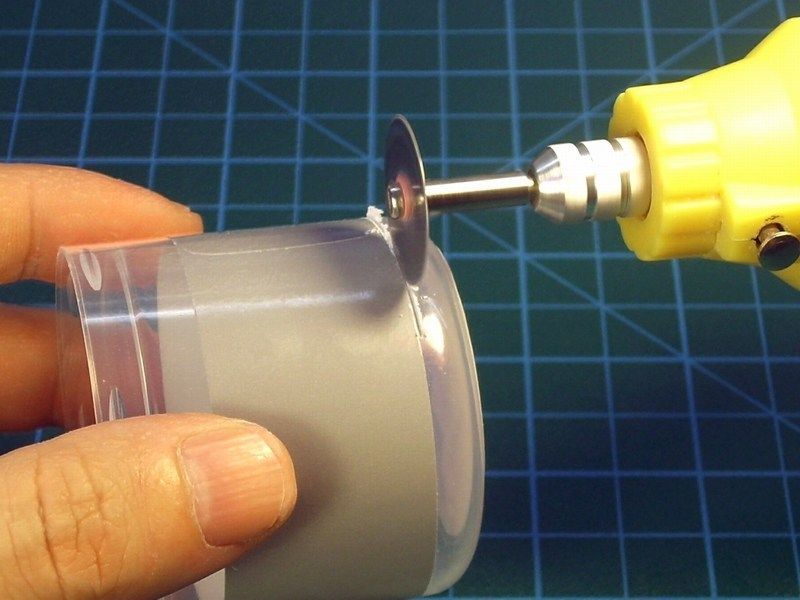
 Using styrene, I split the cap cylinder’s inner area into 4 quadrants. The space of two of these quadrants, would be used as molds, filled with Miliput standard epoxy putty. To ensure that the epoxy putty would be easily removed after the polymerization, a generous coat of baby oil was applied on the contact surfaces. http://www.johnsonsbaby.com/product.do?id=35 - Johnson's baby oil or similar, is well know to anybody who have children in house. If you are not a father yet, ask your sweet girlfriend - all girlfriends have a tiny baby oil bottle in their cosmetics drawer, especially the beautiful and those who pay particular attention to their beauty & appearance. If you don't have a girlfriend, close this web page at once, shut down your PC/laptop and get your feet out of house to meet one! Scale modeling is nice & productive hobby, but feeling a beautiful female next to you, is much better. Thin layers of vaseline based mixtures can be also used instead of baby oil to apply with a soft brush as a segregative material between the styrene side walls and epoxy putty. 



 For those who feel like pioneers and might want to go one step further, you can also use aviation oil.  Aluminum foil was placed underneath to avoid spilling the cut surface and to prevent the epoxy material to stick to the green cutting surface. 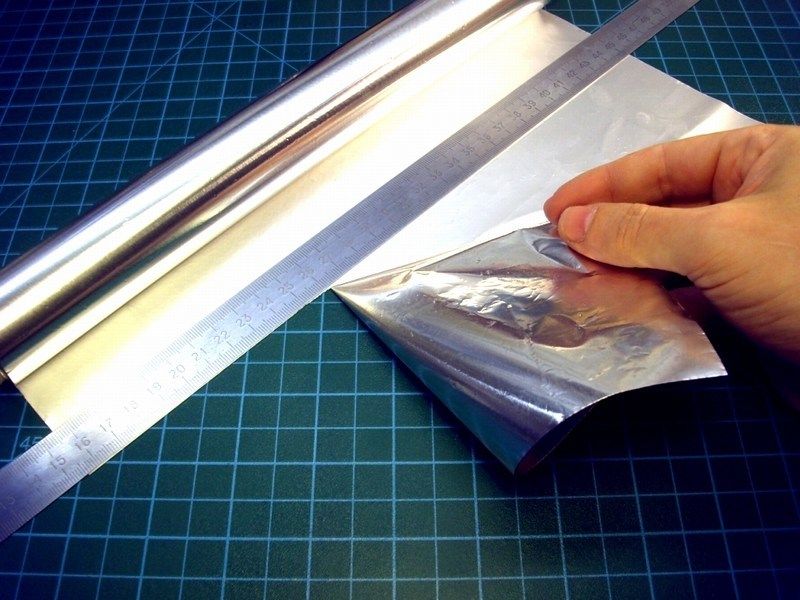

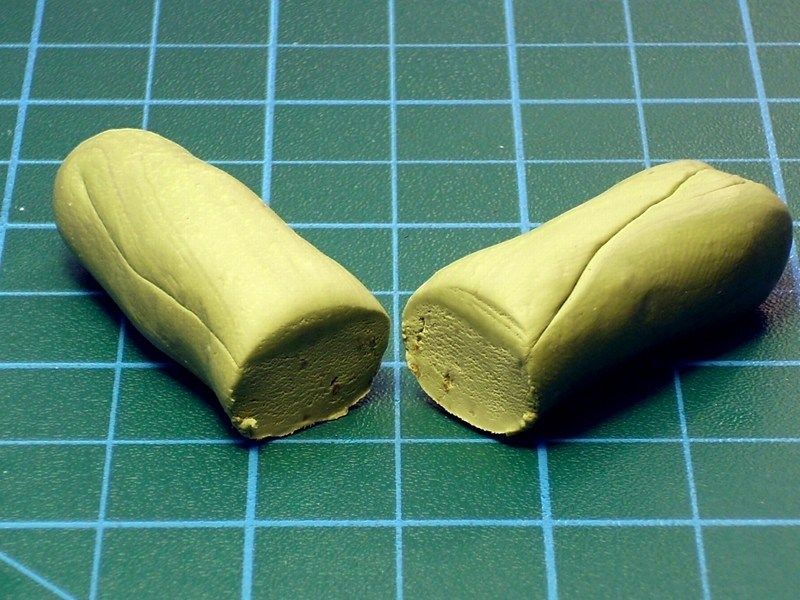 When the cap cylinder, was filled with epoxy putty and had enough time to polymerize and get solid rock, it was slightly pressed and the epoxy cast removed easily. That’s the reason why it would be nice for the cylinder to be made of flexible polyamide material.  With this simple and easy way, two identical pieces with the exact same curvature and volumetric dimensions, were built in just a few minutes. These twin epoxy parts, can be now used as a base to shape into the Bö-102 fuel tanks. Having measured the desired dimensions, the two identical epoxy blocks were cut the same length. Few epoxy overcast remains that were left, were also removed during cutting process. 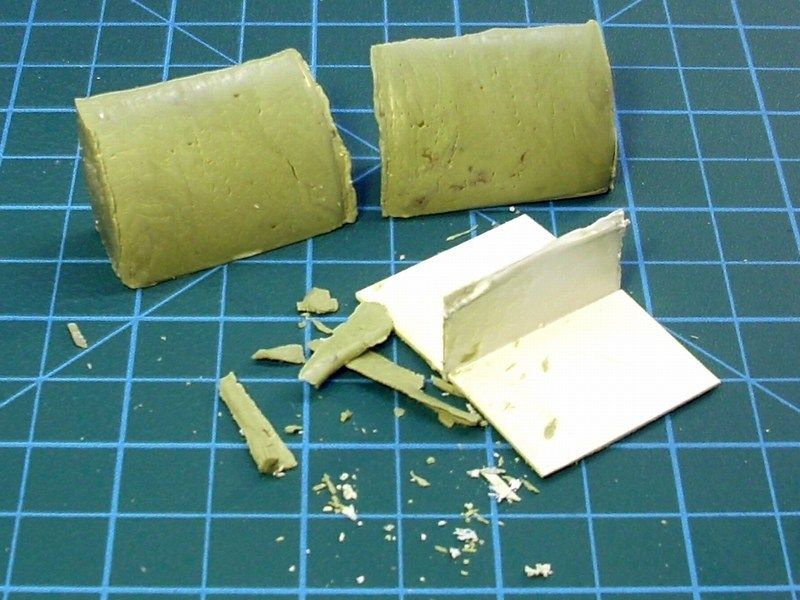
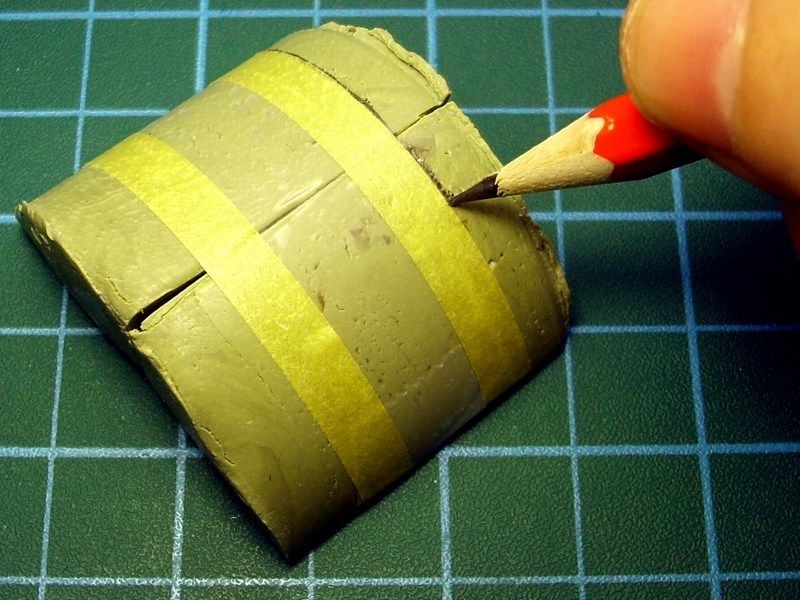 Remember that epoxy materials are dangerous when breath or shallow and could result skin, eyes or lungs severe problems or even cancer when used for long period with no precaution measures. Always keep in mind, that a powerful vacuum system to suck away the epoxy dust should be used all time to keep the workbench area clean while sanding or milling epoxy or resin materials. Using an issued breathing mask and a pair of surgery latex gloves to prevent dust contact with lungs and fingers while sanding or milling epoxy, is also an important matter that you should seriously take care of! My recommendation is to also wear an overall working suit (as I do) to keep your clothes dust free while sanding epoxy. Some people might find it too much, but I wouldn't like to bring epoxy dust & grains from my workbench into living room and my beloved.  …if you are still reading the WIP article so far, you are a proud father already or you have a beautiful girlfriend to spend your money faster than you earn it. |
Mesajý Yazan: nezih
Mesaj Tarihi: 01/07/2011 Saat 15:17
|
Great work! This is a really good lesson for me :) ------------- Sweat saves blood! |
Mesajý Yazan: Nick_Karatzides
Mesaj Tarihi: 05/07/2011 Saat 21:39
The twin epoxy blocks got trimmed and sanded gradually to shape into the desired form and look realistic Helitrainer fuel tanks into scale. Later, few thin layers of liquid scale modelling filler applied over the epoxy to smooth out small imperfections and be seen as a comprehensive outcome.





 |
Mesajý Yazan: Nick_Karatzides
Mesaj Tarihi: 14/07/2011 Saat 01:08
Each fuel tank, is placed on metal plate / receiver base and secured in place by hoops and tensioners, as seen into the following picture.
 In order to reproduce, these metal plate / receiver bases, I tried vacuum forming. Because I was planning to use smaller wooden frame to secure the styrene (the pieces to be vacuum formed are small and there is no need to spend big styrene sheet), I had to close the outer holes on the hardboard high-density fibreboard plate. To do so, I cut a plastic bag in shape and covered as required the desired area. 
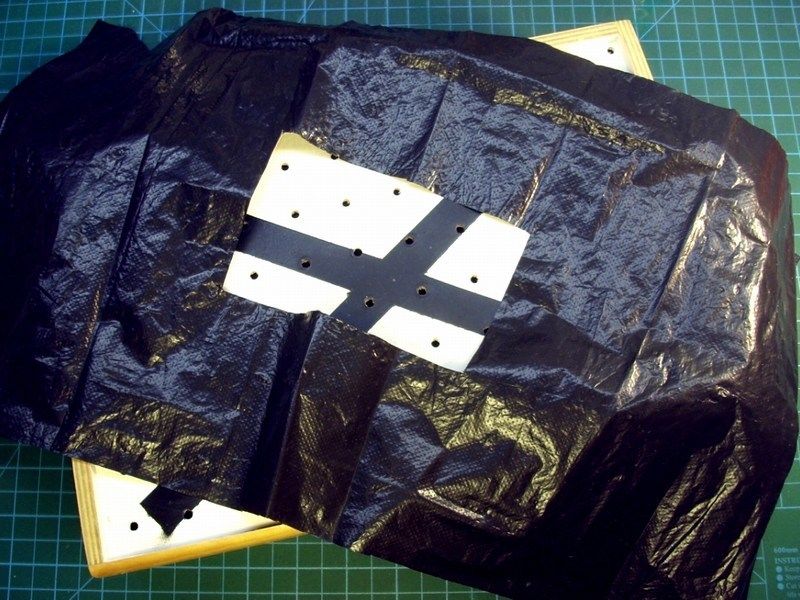 The twin fuel tanks, wedged halfway into http://en.wikipedia.org/wiki/Plasticine - plasticine and placed on the vacuum former plate to form the fuel tanks receivers. 
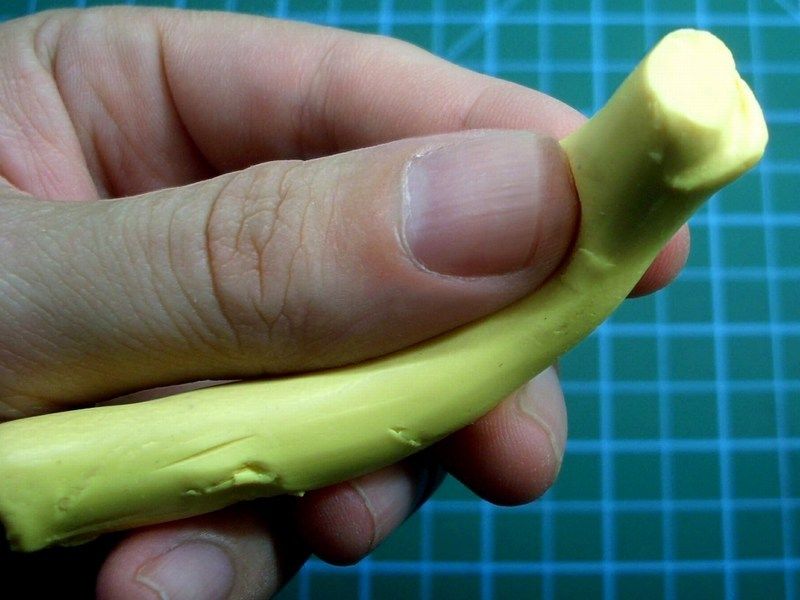

 |
Mesajý Yazan: Nick_Karatzides
Mesaj Tarihi: 14/07/2011 Saat 01:09
I pinned a styrene plastic sheet on the wooden frame, insert it into the preheated electric oven as described before and as soon as I noticed that the plastic got warm enough and started drooping down, I removed it from the oven and thrown the sheet on the vacuum former plate, while the vacuum cleaner was already plugged & switched on. This procedure may take some practice and sometimes a mould tips over or the plastic won’t form properly over the mould (folding around edges). This is also the part where I should warn you that you can burn your fingers - I highly recommend Nomex Aramid flame resistant MilSpec gloves, which I personally use for the job. I buy large plastic styrene 50x30cm sheets for €0.5 to €1.5 each (depending width), not the more expensive styrene by Evergreen. When an attempt fails, I usually throw the sheet back in the oven and start again. Once you have the machine, you can make all kinds of things. You can make a lot of aircraft wings, airframe, panels etc out of a sheet like that. You can make the master moulds from balsa wood, epoxy, polyester etc and the parts you make depend on how accurate the master moulds are. The moulds must be as accurate and detailed as necessary to achieve the results you are after.



 The plastic nicely formed around the fuel tanks moulds and here is how it looks like.  Using a new #11 stainless steel surgical blade, I removed the formed pieces from the styrene sheet. The yellow stuff appears in the picture, is plasticine surplus - the plasticine used to secure the twin epoxy tanks on the vacuum former plate and caged into vacuum formed plastic sheet. Later, these two receiver bases will be sanded as required and some details such as securing hoops and tensioners to keep the twin fuel tanks in place will be added. 
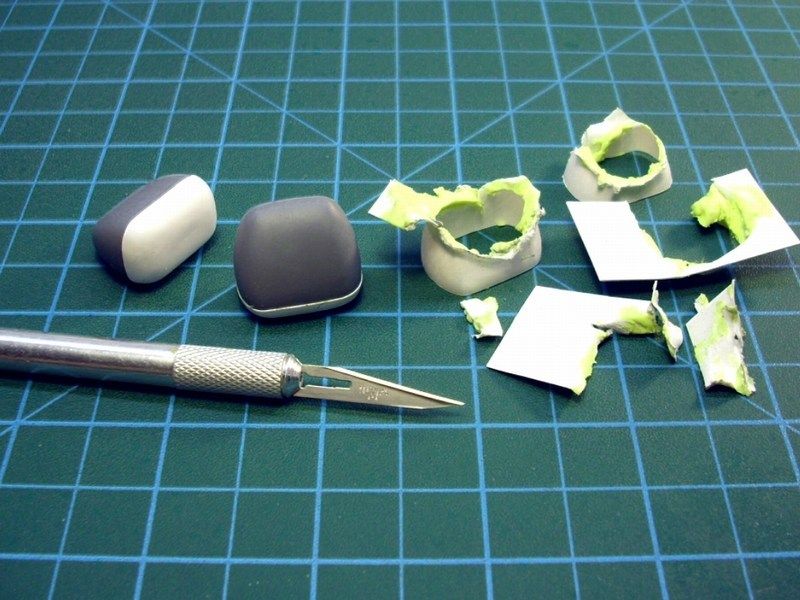
 |
Mesajý Yazan: Nick_Karatzides
Mesaj Tarihi: 14/07/2011 Saat 01:09
Some additional details were added to the fuel tank canisters. The left side fuel tank, was placed on the receiver base and strapped with hoops & tensioners to keep in place, while the right side fuel tank is to be placed on the ground, with the filler cap opened, simulating maintenance procedure.

 |
Mesajý Yazan: AereapeR
Mesaj Tarihi: 15/07/2011 Saat 20:16
| tremendous built progress, looking forward to it! |
Mesajý Yazan: Nick_Karatzides
Mesaj Tarihi: 28/09/2011 Saat 18:31
Finally, the landing pad base supports, built using balsa wood slats.

 |
Mesajý Yazan: Nick_Karatzides
Mesaj Tarihi: 04/10/2011 Saat 02:34
|
The rotor blade is made of styrene sheet softened in boiling water to stretch 'n' turn in a way to look realistic. I also tried soft and careful sanding on the blade's leading edge to be shaped as realistic as it should be. The transmission shaft components and minor details also made of styrene, sprue and metal wire bond together with CA super glue. Everything was sprayed with Humbrol light grey primer when ready to paint. 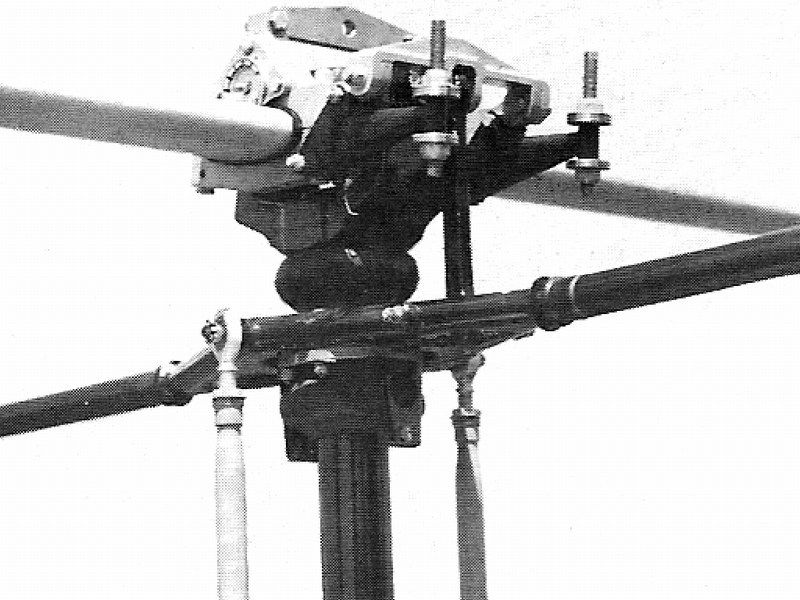

 |
Mesajý Yazan: Nick_Karatzides
Mesaj Tarihi: 04/10/2011 Saat 02:34
|
Model parts were washed with liquid soap and warm water to disappear leaving oil traces, fingertips etc and then sprayed with Humbrol light grey primer. 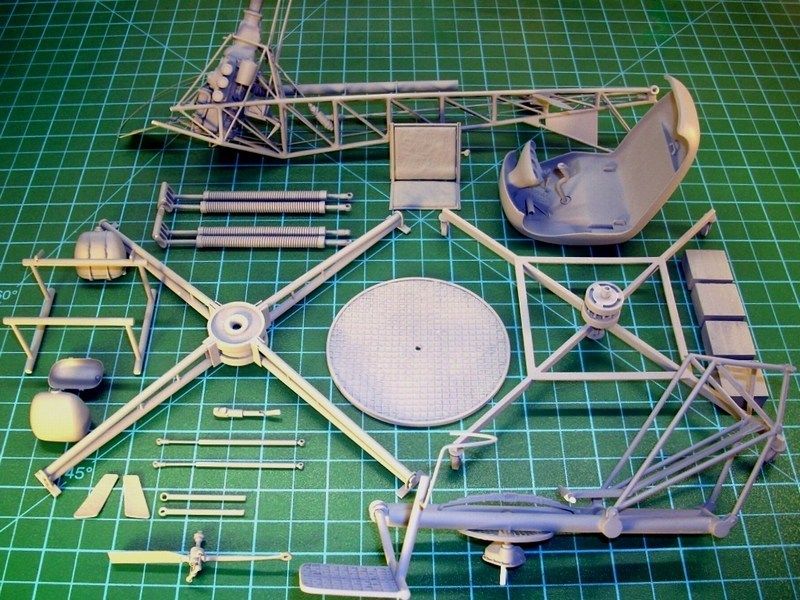 |
Mesajý Yazan: Nick_Karatzides
Mesaj Tarihi: 07/10/2011 Saat 01:35
Usually, there are two available options for a scale modeler, to apply paint on a model:
[*]Assemble the scale model parts first and paint the overall built model later. While building this Bölkow Bö-102 Helitrainer scale model project, the first option seemed as more appropriate and would make my job easy. Unfortunately, I had to follow the second option – and that was not the only bad news. Building first and painting later, would be more difficult and would take much longer, but the reason I chose first to assemble most of parts and paint later, is because most of the Bölkow Bö-102 Helitrainer scale model’s airframe consists of a tail boom structure, in which contained the Hirth 3-cylinder / 2-stroke 40hp ILO L3X375 piston engine, the transmission components, the cable wiring etc that could not be masked without causing any damage. It could be very difficult – maybe impossible - to airbrush for example the tail boom and manage to leave the interior details remain unaffected by the painting same time. Here comes the bad news: Tail boom structure would be painted by using fine brush and lot of patience to avoid leaving any brushing marks that would be clearly visible on such a big scale as the 1/18 is.  After preparing the engine’s basic elements, connecting electric cables and oil or fuel lines, I airbrushed the engine block with Life Color LC24 Matt Aluminium FS37178 acrylic paint as a base coat and apply darker enamel mixtures using the Humbrol #27001, #27002, #27003 metal cote paint and finally add some Mr Metal Color #212 Iron on the engine and let about 24hrs to dry before trying dark brown and black washes. 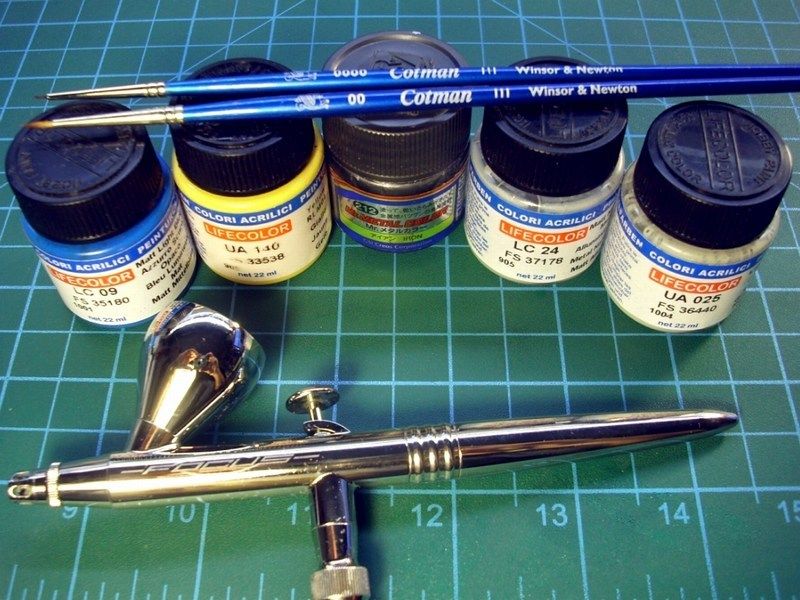
 As I personally believe that following simple techniques and sometimes unconventional methods, result in superior effects, I usually do not use enamel or acrylic paint to wash, because I feel risky when applying the paint mixture and let it run. I prefer an easier technique that can be undone if the results are poor - that makes it the perfect technique. I use hard chalk pastels to wash (NOT oil pastels). The hard chalk pastels, looks like a teacher would use on the blackboard in school. Do not use the soft oil pastels that artist use to draw on paper. The hard chalk pastels are easy to find in a variety of colours into your local art store or maybe http://www.walmart.com - Wal-Mart if in US or http://www.asda.co.uk - ASDA if in UK.  To do the wash, I use an blade, a small metal or plastic container, an old toothbrush, dish washing soap and a bit of water. Begin by scraping some chalk powder from the side of the chalk pastel stick, carefully put this chalk powder into the small container and add a tiny amount of water and stir. It is important to add a tiny amount of water in order to make the mixture look like mud - not like soup! For this reason, I use a syringe to add just few drops on the hard chalk pastel powder and I stir using the old brush. Because the chalk powder doesn't mix well with the water, a drop of dish washing soap is needed to break the surface tension of the water and also acts as a “glue” to help the chalk powder stick to the model. 
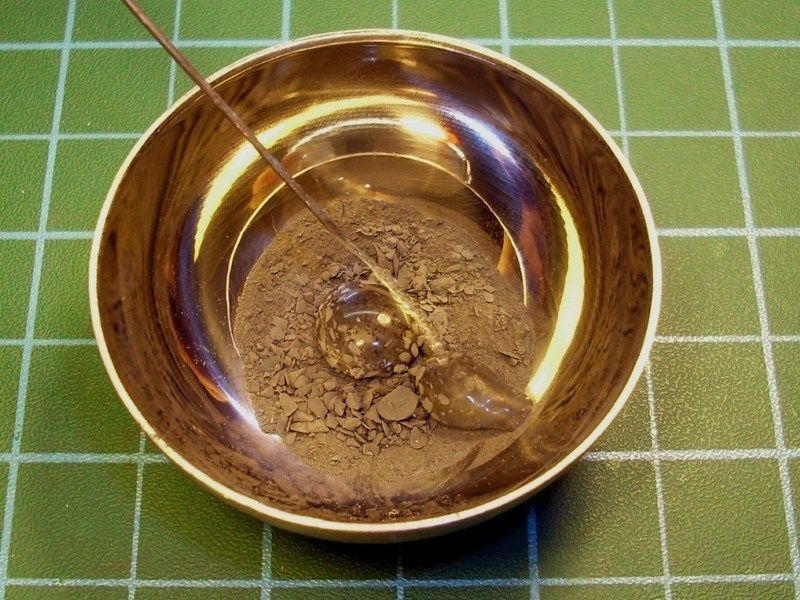 Once the chalk is fully dissolved into the water/soap mixture it is time to “paint” this mixture onto the model's engine. “Painting” the mixture is simple - just apply it anywhere it is needed to darken recessed detail. The mixture can be applied carelessly, because any mistakes can be completely removed and redone. Once the chalk wash dried, I rubbed off the high spots with a slightly damp dry (not wet) Q-Tip cotton swab (Kleenex papers can be also used) and I wiped the dark colour from the areas should be light & shinny. The high spots were cleaned to the bare metal finish and the low spots were left black. I did the chalk wash on the engine in under 30 minutes which makes it a very quick and effective technique. 


 Some of the wash mixture is re-applied and the wash being wiped completely out of the narrow points. If you follow this method, it is adviced to not rinse out the wash container till you are finished this job. You will probably be touching up certain spots a few times, so it helps if you're not mixing up a new chalk mixture each time because you kept cleaning out your container of the chalk wash mixture. As soon as I paint the electric cables, the oil or fuel lines etc, I repeated the wash process with lighter colours where needed. Using micro cotton batons found into cosmetic shop for less than 1£, I applied some brown chalk pastel powder on the engine's chrome exhaust, to make it look overheated. I repeated the weathering process until it satisfied me and finally I sprayed a Humbrol clear coat to seal the chalk powder on the engine. |
Mesajý Yazan: Nick_Karatzides
Mesaj Tarihi: 07/10/2011 Saat 21:59
Dark brownish pigments & chalk powder shades, dissolved in water and spread in selected engine block spots gave a better look. When satisfied with the result, I began the tail boom painting process. To do so, I used the Life Color UA140 Yellow RLM 04 FS33538 colour which is actually the colour found into the official Bölkow’s technical order manual. Paint applied over 2-3 very diluted (almost pure water) thin layers, one after another, using a fine brush, keeping in mind that leaving paint marks should be avoided.

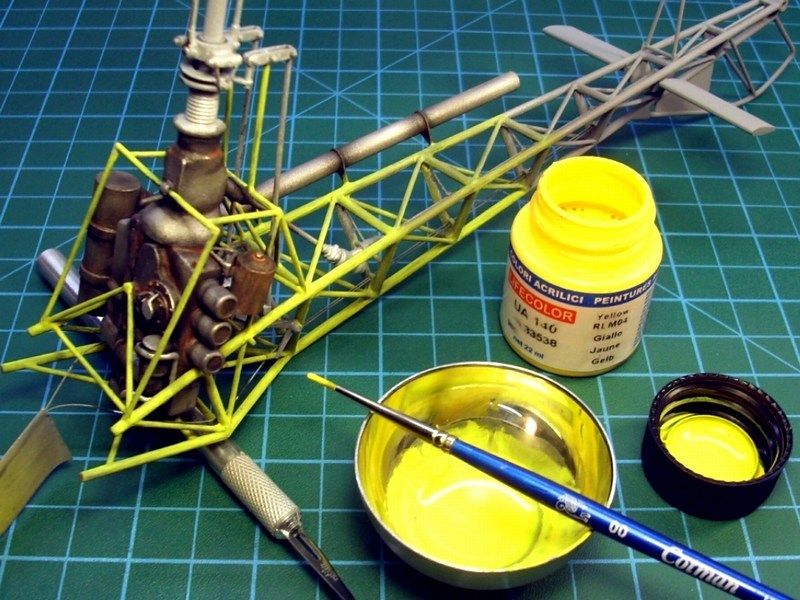 |
Mesajý Yazan: Nick_Karatzides
Mesaj Tarihi: 14/10/2011 Saat 02:54
|
I found nice idea to place the Bö-102 Helitrainer on a display base, simulating a concrete ground area. The idea was to establish the picture of an abandoned small airfield in Vlotho, where the Helitrainer used to rest for decades till found and finally donated to the Hubschraubermuseum helicopter museum in Bückeburg, Germany. The museum workshop team, managed to restore it and display it as on of these experimental helicopter training devices. From my local store, I bought a 20x30cm polished wooden picture frame.  I add some grams of plaster powder and few drops of water with a syringe into a soft rubber cup to make the right mixture. Materials like plaster, start as a dry powder that is mixed with water to form a paste which liberates heat and then hardens. Unlike mortar and cement, plaster remains quite soft after drying and this characteristic make plaster suitable for the job. Keep in mind that adding salt into wet plaster mixture, reduce the plaster's hardening time and adding vinegar into wet plaster mixture, extend the plaster's hardening time. When the first layer of thinned plaster applied on the picture frame, a glass were pushed against the plaster to form a flat basic strong cast. The basic idea, is to produce a totally flat cast and later add some detail or apply extra stuff where is needed. 



 I left it few hours to get harden in order to be sure that the cast wouldn't break when I would try to cut it into desired shape. Meanwhile, I took the soft rubber cup which I used to make the plaster mixture, squized it to break the last hardened plaster left inside, so it would be easier for me to clean it afterwards and prepare it for any future mix. That's the reason this soft rubber cup were used for. 
 As soon as the plaster cast got harden, cut into shape and the concrete plaques were lined with a scriber, I used my airbrush to paint it. After the polished wooden frame was covered with masking tape, three different acrylic paint layers were applied on the plaster surface. First, mat black colour covered the area and then a light grey applied with airbrush, spraying in almost zero degrees angle, to let the darker areas between the concrete plaques remain naturally dark. The corner was paint with earth tones and as soon as the acrylic colours dried, I tried some drybrushing on selected spots using sand tones.  As for he grass & plants, I used different colors of static grass from my local hobby shop, empty them into a plastic box and make a mixture. 
 Water based white glue for wood, which becomes transparent when it dries, is just the right for the job. So, I opened a 500gr canister bought for €2 only, pick a small quantity, add just few drops of water with a syringe into a small metal container to make the right mixture and finally I applied on the desired areas to be filled with grass & plants, using a wet brush. Because the mixture is enriched with water based glue, it is easy to correct possible mistakes. 
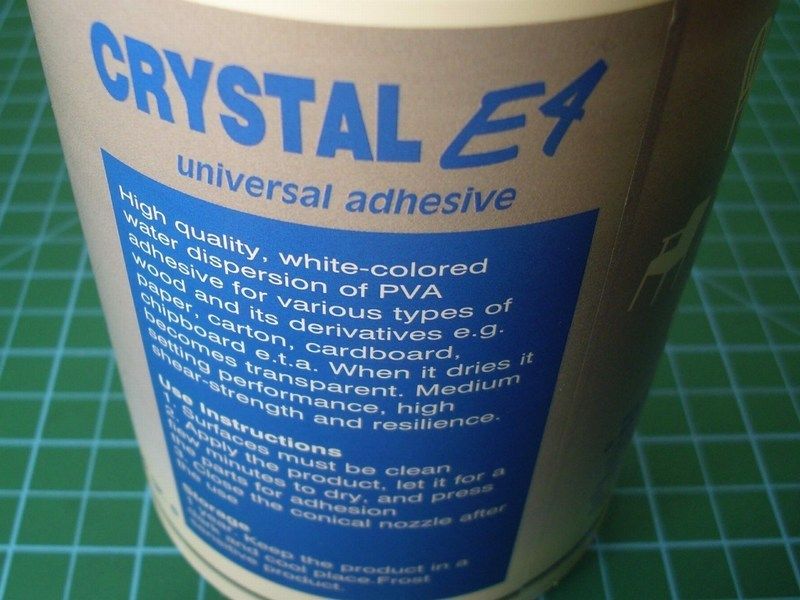


 As soon as the result was OK, I sprayed over with Humbrol enamel mat coat, to seal the paint and grass, so far. I left it overnight and as soon as the enamel mat coat dried, I add very few light & dust effects with chalk dust and pigments. |
Mesajý Yazan: Nick_Karatzides
Mesaj Tarihi: 14/10/2011 Saat 02:56
|
As soon as the individual scale model’s parts were already painted & weathered, I had to conclude the most difficult part. To assembly everything in one piece, without damaging the construction, the paint, the weather effect and of course ,my patience. That’s why I had to constantly monitor and try dry fit tests for each part during each step of this project, to ensure that I will not face any nasty surprises. The landing pad & the wheeled supporting base construction, would be the first to be placed on the tarmac display base. Everything secured in place with hidden pins encased in plaster & glued with CA super glue. 


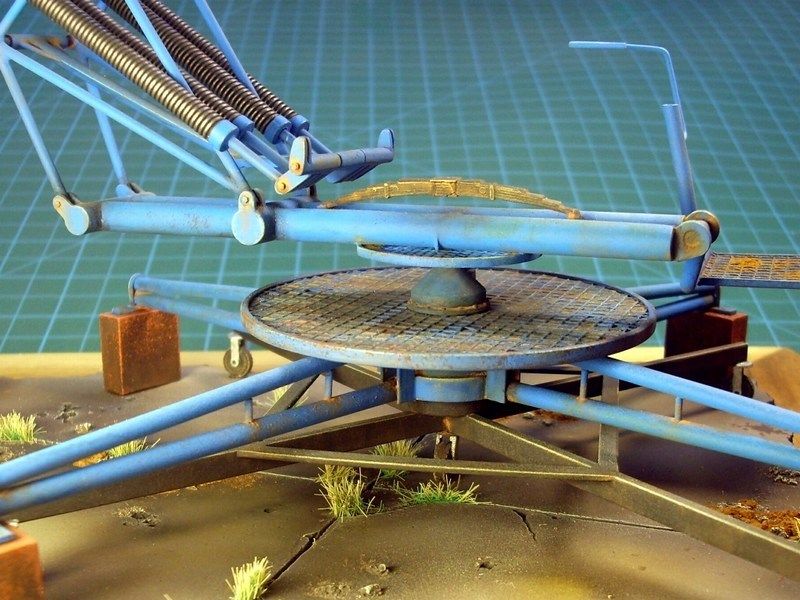 |
Mesajý Yazan: mithat
Mesaj Tarihi: 14/10/2011 Saat 09:38
|
Sevgili Nick, bu e?itici, ö?retici ve inanylmaz güzel çaly?mandan dolayy önce te?ekkür sonra da tebrik ederim... ------------- mithat |
Mesajý Yazan: Nick_Karatzides
Mesaj Tarihi: 15/10/2011 Saat 23:15
|
The Bö-102’s cabin and one-piece glass bubble canopy, offers wide visibility for the student pilot. The absence of side doors is a benefit in a hot climate and also provides better vocal communication with trainer who sits nest to student pilot. Of course, canopy modifications can be done, as seen Bö-102s with total absence of glass canopy. As written and described into previous “CHAPTER” I, the basic shape of the thin-skinned, right-to-scale bubble typed canopy, was made by vacuum forming 1mm clear polycarbonate sheet, on a solid rock one-piece image cast made of modeling clay and additional layers of epoxy putty & polyester filler with fiberglass grains. To do so, the clear sheet were pined on a wooden frame, preheated into electric oven and as soon as I noticed that it started drooping down, I vacuum formed it. The clear sheet nicely formed around the canopy cast following the curves & details as planed. Using an X-acto knife, I removed the formed canopy bubble from the transparent sheet and start adding details, such as canopy's frame.  The clear canopy frame was made by 1mm masking tape. Few drops of CA super glue applied on the right spots with great caution. Remember that CA super glue does fog the transparent parts and this canopy would not be an exception - that's why I placed some very tiny drops of it, just on few spots to secure the installation. 
 |
Mesajý Yazan: Nick_Karatzides
Mesaj Tarihi: 17/10/2011 Saat 02:40
After placing the clear canopy on cabin and adding few tiny drops of CA super glue just on few spots to secure the installation, small amounts of Squadron MMD green putty filled tiny gaps. Later, the green putty overages sanded lightly and the cabin prepared for airbrushing. The cabin was painted using the Life Color UA025 Light Gull Grey FS36440 acrylic paint and later the lower part was dusted by airbrushing a very light layer of Life Color LC37 Matt Burnt Umber FS3004 acrylic paint.

 |
Mesajý Yazan: Nick_Karatzides
Mesaj Tarihi: 19/10/2011 Saat 21:27
|
I almost forgot to build the instructor’s bicycle type seat in which he sits, next to the student pilot. Using http://en.wikipedia.org/wiki/plasticine - plasticine , I made an image cast of how I would like seat’s surface to look like. I only had to push the material gently with fingers and got the desired shape - in fact, the process took less than 5 seconds. 

 Using a small amount of Milliput putty, I made a small ball, dust it with talcum powder and pressed it against the working bench with a roller until it becomes as thin as could get. The use of talcum powder is necessary to avoid Milliput sticking on roller or fingers and get easier to handle without tearing to pieces. 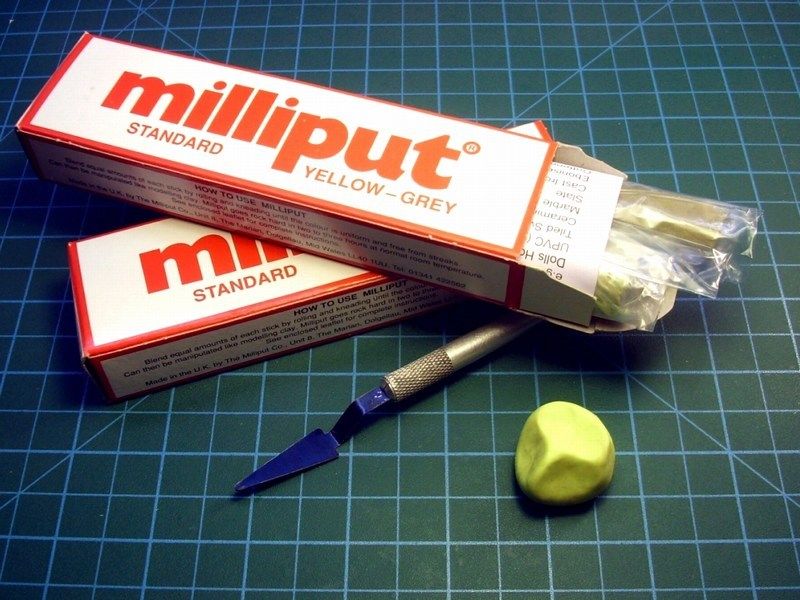

 When the Milliput was pretty thin, I lifted it and place it on the plasticine image cast I made earlier, to let it follow the shape and curves of the seat. Using an old wet brush, I let few drops of water on the Milliput sheet, to make it softer and easier to follow the seat shape and left it overnight to get harden. Of course, the same technique can be also used to build blankets, truck covers, etc. 

 I left the Milliput overnight to get polymerized. As soon as it was got harden, I removed the plasticine image cast and cut the seat, as shown into the following pictures. 

 Using airbrush, basic blue colour and shades of sand & rusty brown tones sprayed at low pressure to represent the weathering and dusting on the seat and the lower part of the landing pad with supporting base. After a satisfactory weathering result, the scale model was sprayed with mat enamel coat and left 24 hours to dry. |
Mesajý Yazan: Nick_Karatzides
Mesaj Tarihi: 19/10/2011 Saat 21:52
|
Final details were added and I tried some close-up pictures. Although initially I plan to represent a brand new bright ‘n’ shiny Bölkow Bö-102 Helitrainer, I changed my mind during the building process and finally decide to present as found in an abandoned small airfield in Vlotho, where the Helitrainer used to rest for decades till found and finally donated to the Hubschraubermuseum helicopter museum in Bückeburg, Germany. The museum workshop team, managed to restore it and display it as on of these experimental helicopter training devices. That is why I preferred to add much wear, dust and stains from oil and scorched medals at several points and some rust as example in the exhaust. I tried black paper background (instead of white) & different light conditions. 



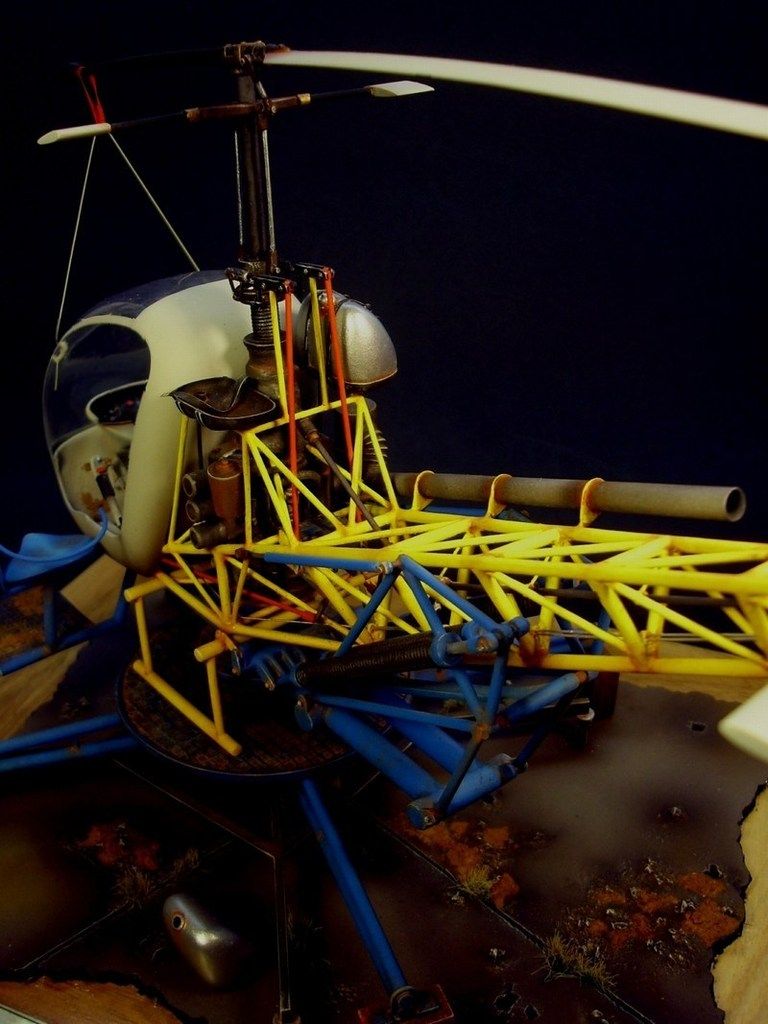
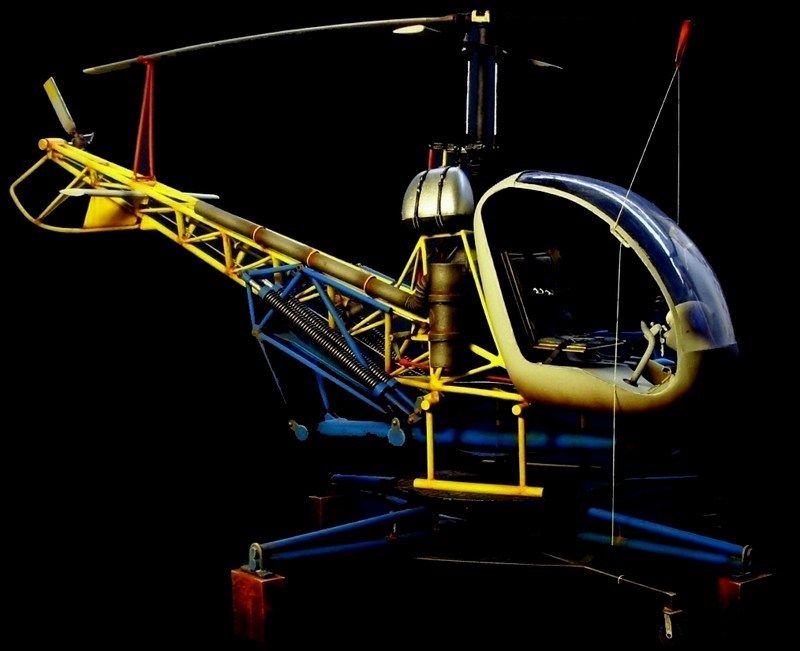 |
Mesajý Yazan: amsl152
Mesaj Tarihi: 21/10/2011 Saat 18:39
|
I am speechless; who could make any comment other than saying "just an amazing work and patience"
Congratulations for the piece of such an art .. |
Mesajý Yazan: Clumsy
Mesaj Tarihi: 22/10/2011 Saat 08:29
|
Well, i have nothing to say but Bravo!
I was lucky see one of your work (red gyro) with my own eyes at Kavala two years ago and i hope to see this in the following contest again. Thanks for sharin' ------------- -Sorumluuu... -Yok, yoook kesinlikle sorumlu de?il canym. Olsa olsa ancak sorunlu olur! -Peki o zaman. Sorunluuu... |
Mesajý Yazan: Nick_Karatzides
Mesaj Tarihi: 28/10/2011 Saat 08:38
|
I would like to express my special thanks to:
[*]Mr. George Papadimitriou, owner of http://hobbygallery.gr - Hobby Gallery hobby shop and exclusive distributor for LifeColor & AK Interactive products in Greece, for his kind support and providing all the goodies I asked for - from A to Z. [*]My sweetheart wife, who actively participated in the project as an indispensable assistant, offering me relaxing neck massage while working on my bench. 
 Finally, for those who are interested to check more info & pics, feel free to have a look on our http://www.shapeways.com/shops/anyuta3D - Anyuta 3D printed scale models products catalog. Wife as website operator & sales cordinator is always ready to answer customer questions regarding 3D printed scale model kit & diorama accessories products. Thank you all for following this thread and I hope you enjoyed reading this article. I’ll meet you soon, on my next WIP - possibly a 3D printed.one. Regards, Nick 
 |